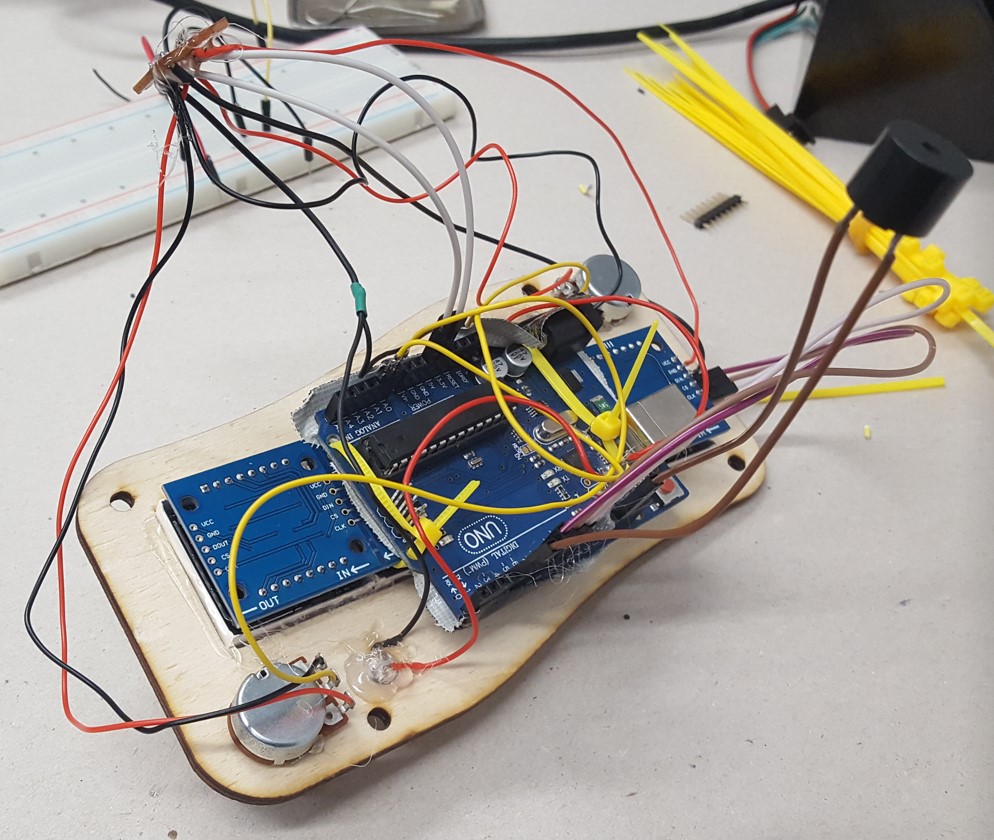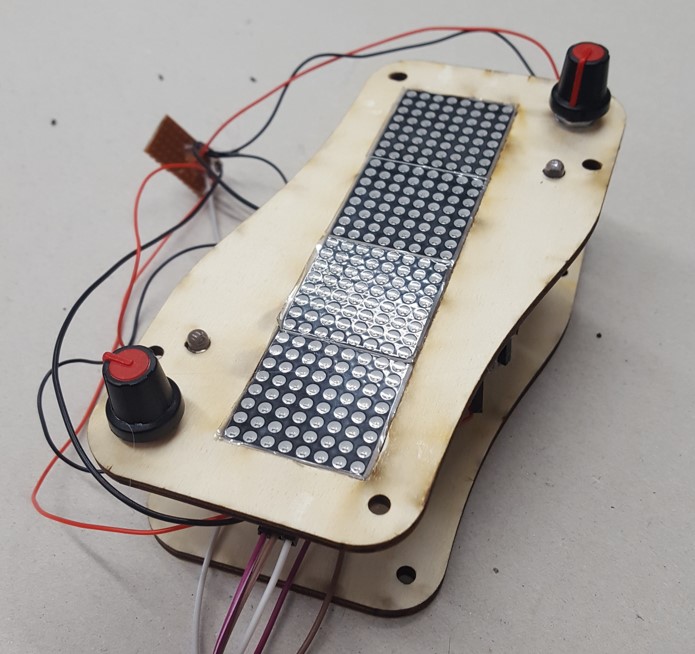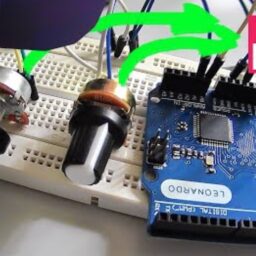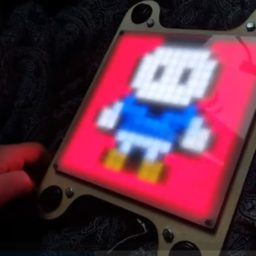updated 32×8 matrix This updated version makes use of the very limited, but therefore simple matrix library made by ELECTRO707. …
updated 32×8 matrix
This updated version makes use of the very limited, but therefore simple matrix library made by ELECTRO707. It comes with basic buffer routines to animate text and images along the display.
main.cpp
Updated an finalized code!
#include <Arduino.h>
// thanks for the help: https://registry.platformio.org/libraries/electro707/Simple%20LED%20Matrix
// code doc is here: https://electro707.com/documentation/Libraries/simple_led_library/stable/classsimple_matrix.html
// fantastic standalone pixel array EDITOR > https://github.com/Electro707/LED_Matrix_Generator
int hiscore = 0;
uint8_t HAPPY1[] = {
0b1111110,
0b11000011,
0b10000001,
0b11111111,
0b11011011,
0b11011011,
0b11111111,
0b1111110,
0b0,
0b0,
0b0,
0b0,
0b0,
0b0,
0b0,
0b0,
0b0,
0b0,
0b0,
0b0,
0b0,
0b0,
0b0,
0b0,
0b0,
0b0,
0b0,
0b0,
0b0,
0b0,
0b0,
0b0
};
uint8_t HAPPY2[] = {
0b0,
0b0,
0b0,
0b0,
0b0,
0b0,
0b0,
0b0,
0b0,
0b0,
0b0,
0b0,
0b0,
0b0,
0b0,
0b0,
0b0,
0b0,
0b0,
0b0,
0b0,
0b0,
0b0,
0b0,
0b1111110,
0b11111111,
0b11011011,
0b11011011,
0b11111111,
0b10000001,
0b11000011,
0b1111110
};
#include "simple_matrix.h" //Import the library
//#include "spritesheets.h"
//#include "leds.h"
/*
// helper function to copy pixel arrays
void copy(uint8_t* src, uint8_t* dst, int len) {
memcpy(dst, src,len);
}
*/
/*
If you notice that the display is upside-down per display, change
simpleMatrix disp(4, false, NUMBER_OF_DISPLAYS); to simpleMatrix disp(4, true, NUMBER_OF_DISPLAYS);
DIN D11 (Fixed)
CLK D13 (Fixed)
CS D4 (Adjustable by software)
*/
simpleMatrix dotmatrix(8, true, 4); // init the dotmatrix
int poti_one_pin = A0;
int poti_two_pin = A1;
int one_in_raw = 0;
int two_in_raw = 0;
float one_in = 0;
float two_in = 0;
float fposx = 0;
float p2_x = 4;
float p1_x = 4;
int p_bxi = 4;
int p_byi = 16;
float bx = 4;
float by = 16;
float bax = .3;
float bay = .8;
float ball_speed= .4;
int game_state = 0;
int buzzer_pin = 3;
bool game_running = false;
int p_bid = 0; // previous brush id - used to avoid overhead
int age = 0;
long reset_ts = -1;
/*
void update_brush(uint8_t* _IMG){
copy(_IMG,BRUSH,8);
}
*/
int led1_pin = 5;
int led2_pin = 6;
int led1_age = 4;
int led2_age = 4;
void leds_update(){
if( led1_age>0){led1_age--; analogWrite(led1_pin,44);}else{ digitalWrite(led1_pin,LOW);}
if( led2_age>0){led2_age--;analogWrite(led2_pin,44);}else{ digitalWrite(led2_pin,LOW);}
}
void readInputs(){
one_in_raw = analogRead(poti_one_pin);
two_in_raw = analogRead(poti_two_pin);
one_in = one_in_raw*0.0009765625; // same as /1024 but faster :)
two_in = two_in_raw*0.0009765625; //
}
void idleMode(){
dotmatrix.setIntensity(1);
int rx = random(8);
int ry = random(32);
dotmatrix.clearPixel(rx,ry);
rx = random(8);
ry = random(32);
dotmatrix.setPixel(rx,ry);
//tone(buzzer_pin,random(400)+400,20);
}
void resetBall(){
dotmatrix.clearDisplay();
game_state = 0 ;
bx = 4;
by = 16;
bay = (random(4)+6)*.1;
bax = random(1)-.5;
if(random(10)>5){
bay = -bay;
}
ball_speed= .5;
}
int p_one_score = 0;
int p_two_score = 0;
void resetGame(){
p_one_score = 0;
p_two_score = 0;
}
void setup() {
//Serial.begin(9600);
dotmatrix.begin();
//Set the LED's intensity. This value can be anywhere between 0 and 15.
dotmatrix.setIntensity(8);
dotmatrix.clearDisplay();
resetBall();
pinMode(led2_pin, OUTPUT);
pinMode(led1_pin, OUTPUT);
}
void showWinner(int wid){
game_running = false;
for(int i=0;i<9;i++){
dotmatrix.clearDisplay();
delay(100);
if(wid==1){
dotmatrix.sendMatrixBuffer(HAPPY2);
}
if(wid==2){
dotmatrix.sendMatrixBuffer(HAPPY1);
}
tone(buzzer_pin,888+int(random(200)),20);
delay(100);
}
//noTone();
resetGame();
//idleMode = true;
}
char* intToString(int number) {
static char buffer[12]; // Create a static buffer to hold the string representation
sprintf(buffer, "%d", number); // Convert the integer to string using sprintf
return buffer;
}
void showScore(){
//dotmatrix.scrollText("2350",60,false );
char* str = intToString(hiscore) ; //hiscore
dotmatrix.scrollText( str ,20,false );
if(p_two_score>2){
dotmatrix.scrollText( str ,60,false );
dotmatrix.scrollText( str ,60,false );
showWinner(2);
}
if(p_one_score>2){
dotmatrix.scrollText( str ,60,false );
dotmatrix.scrollText( str ,60,false );
showWinner(1);
}
dotmatrix.clearDisplay();
//dotmatrix.print("1",1,)
for(int p1=0;p1< p_two_score;p1++){
for(int i=0;i<6;i++){
dotmatrix.setPixel(i+1,1+p1*2);
}
}
for(int p2=0;p2< p_one_score;p2++){
for(int i=0;i<6;i++){
dotmatrix.setPixel(i+1,31-p2*2);
}
}
delay(1000);
}
void loop() {
if(digitalRead(2) && !game_running){
dotmatrix.clearDisplay();
game_running = true;
tone(buzzer_pin,888+int(random(200)),20);
}
if(!game_running){
idleMode();
return;
}
if( game_state == 0){
// repel X
if(bx >= 7 || bx < 1){ bax *=-1;}
if(int(by) == 2){
float diff = abs(bx - float(p2_x)-.75);
if(diff<1.95){
bay *=-1;
by++;
bax *= random(9,11)*.12;
ball_speed += .06;
tone(buzzer_pin,1449,18);
led1_age = 4;
hiscore+=50; // count score up each paddle hit
}
}
if(int(by) <= 1){
tone(buzzer_pin,1009,43);
p_one_score++;
game_state = 1;
reset_ts = millis()+360;
hiscore-=20; // count score DOWN each paddle miss
//by = 16;
showScore();
}
// if player one collision
if(int(by) == 30){
float diff = abs(bx - float(p1_x)-.75);
if(diff<1.95){
by--;
bay *=-1; // repel!
bax *= random(9,11)*.12;
led2_age = 4;
ball_speed += .06;
tone(buzzer_pin,1999,18);
hiscore+=50; // count score up each paddle hit
}
}
if(int(by) >= 31){
tone(buzzer_pin,1009,43);
game_state = 1;
reset_ts = millis()+360;
p_two_score++;
hiscore-=20; // count score DOWN each paddle miss
showScore();
//by=16;
}
bx += bax*ball_speed;
by += bay*ball_speed;
//p2_x = bx; // autopilot
p2_x = int(8-two_in*8);
p1_x = int(one_in*8);
}
// read analog inputs
readInputs();
if( game_state == 0){
// GAMEPLAY!!! ------------
// draw ball!
dotmatrix.setPixel(bx,by);
if(p_bxi != int(bx) || p_byi != int(by)){
dotmatrix.clearPixel(p_bxi,p_byi);
}
// just clear pedal row
for(int i=0;i<8;i++){
if( abs(p2_x -i ) > 1.1){
dotmatrix.clearPixel(i,1);
}else{
dotmatrix.setPixel(i,1);
}
if( abs(p1_x -i ) > 1.1){
dotmatrix.clearPixel(i,30);
}else{
dotmatrix.setPixel(i,30);
}
}
}
if( game_state == 1){
// pause mode if goal is made!
if( reset_ts < millis() ){
// reset the game!
resetBall();
}
return;
}
// save last postions for elements for cleanup drawing!
p_bxi = int(bx);
p_byi = int(by);
leds_update();
delay(1);
}
#include <Arduino.h>
// thanks for the help: https://registry.platformio.org/libraries/electro707/Simple%20LED%20Matrix
// code doc is here: https://electro707.com/documentation/Libraries/simple_led_library/stable/classsimple_matrix.html
// fantastic standalone pixel array EDITOR > https://github.com/Electro707/LED_Matrix_Generator
#include "simple_matrix.h" //Import the library
#include "sprites.h" // import my sprites
/*
If you notice that the display is upside-down per display, change
simpleMatrix disp(4, false, NUMBER_OF_DISPLAYS); to simpleMatrix disp(4, true, NUMBER_OF_DISPLAYS);
DIN D11 (Fixed)
CLK D13 (Fixed)
CS D4 (Adjustable by software)-
*/
simpleMatrix dotmatrix(8, true,4); // init the dotmatrix
int poti_one_pin = A0;
int poti_two_pin = A1;
int one_in_raw = 0;
int two_in_raw = 0;
void setup() {
dotmatrix.begin(); // startup the matrix
//Set the LED's intensity. This value can be anywhere between 0 and 15.
dotmatrix.setIntensity(1);
dotmatrix.clearDisplay();
}
void readInputs(){
one_in_raw = analogRead(poti_one_pin);
two_in_raw = analogRead(poti_two_pin);
//one_in = one_in_raw*0.0009765625; // same as /1024 but faster :)
//two_in = two_in_raw*0.0009765625; //
}
void loop() {
readInputs(); // read my two analog inputs
if(one_in_raw <= 200){
dotmatrix.sendMatrixBuffer(FACEY[0]);
}
if(one_in_raw > 200 && one_in_raw<=600){
dotmatrix.sendMatrixBuffer(FACEY[1]);
}
if(one_in_raw > 600 && one_in_raw<=900){
dotmatrix.sendMatrixBuffer(FACEY[2]);
}
// draw a moving dot above the drawn buffer
int px = sin(millis()*.01)*6+16;
dotmatrix.setPixel(4,px);
// ------ !!!!! ATTENTION > this routine delays the whole loop until finised! -------------
if(one_in_raw > 900){
// scroll any text > .scrollText( "text" , speed , direction )
dotmatrix.scrollText("Oh je!",18,false);
}
delay(10);
}
sprites.h
uint8_t FACEY[3][32] = {
{
0b0,
0b100000,
0b110000,
0b110000,
0b110000,
0b100010,
0b100,
0b1000,
0b10000,
0b10000,
0b10000,
0b10000,
0b10000,
0b10000,
0b10000,
0b10000,
0b10000,
0b10000,
0b10000,
0b10000,
0b10000,
0b10000,
0b1000,
0b100,
0b10,
0b100000,
0b110000,
0b110000,
0b110000,
0b100000,
0b0,
0b0
}
,
{0b0,
0b0,
0b110000,
0b1111000,
0b1111000,
0b110000,
0b0,
0b100,
0b10,
0b10,
0b10,
0b10,
0b10,
0b10,
0b10,
0b10,
0b10,
0b10,
0b10,
0b10,
0b10,
0b10,
0b10,
0b100,
0b1000,
0b0,
0b110000,
0b1111000,
0b1111000,
0b110000,
0b0,
0b0
}
,
{
0b0,
0b100000,
0b1000000,
0b1000000,
0b1000000,
0b1000000,
0b100000,
0b100,
0b10,
0b10,
0b10,
0b10,
0b10,
0b10,
0b10,
0b10,
0b10,
0b10,
0b10,
0b10,
0b10,
0b10,
0b10,
0b100,
0b101000,
0b1000000,
0b1000000,
0b1000000,
0b1000000,
0b1000000,
0b100000,
0b0}};

The standalone pixel array converter and editor can be downloaded here for props > https://github.com/Electro707/LED_Matrix_Generator

parts list
in real life
This execution is not a proper way to design things – this is rapid prototyping by definition using simple lasercut, prototyping boards, freehand soldering and a lot of hotglue. done 🙂
the code
The MICOR:TWO code is based on an external libary to deal with the dotmatrix in general. This makes it much more easier to handle images or typography in general. Check out the commented code to get into detail 🙂
leds.h
int led1_pin = 5;
int led2_pin = 6;
int led1_age = 4;
int led2_age = 4;
void leds_update(){
if( led1_age>0){led1_age--; analogWrite(led1_pin,44);}else{ digitalWrite(led1_pin,LOW);}
if( led2_age>0){led2_age--;analogWrite(led2_pin,44);}else{ digitalWrite(led2_pin,LOW);}
}
spritesheets.h
uint8_t UP[] = {
0b11000,
0b11000,
0b11000,
0b11000,
0b11000,
0b11000,
0b11000,
0b0,
0b10000001,
0b1000010,
0b100100,
0b11000,
0b0,
0b10000001,
0b1000010,
0b100100,
0b11000,
0b0,
0b10000001,
0b1000010,
0b100100,
0b11000,
0b0,
0b10000001,
0b1000010,
0b100100,
0b11000,
0b0,
0b10000001,
0b1000010,
0b100100,
0b11000
};
uint8_t DOWN[] = {
0b11000,
0b100100,
0b1000010,
0b10000001,
0b0,
0b11000,
0b100100,
0b1000010,
0b10000001,
0b0,
0b11000,
0b100100,
0b1000010,
0b10000001,
0b0,
0b11000,
0b100100,
0b1000010,
0b10000001,
0b0,
0b11000,
0b100100,
0b1000010,
0b10000001,
0b0,
0b0,
0b11000,
0b11000,
0b11000,
0b11000,
0b11000,
0b11000
};
main.cpp
#include <Arduino.h>
// thanks for the help: https://registry.platformio.org/libraries/electro707/Simple%20LED%20Matrix
// code doc is here: https://electro707.com/documentation/Libraries/simple_led_library/stable/classsimple_matrix.html
// fantastic standalone pixel array EDITOR > https://github.com/Electro707/LED_Matrix_Generator
#include "simple_matrix.h" //Import the library
#include "spritesheets.h"
#include "leds.h"
/*
// helper function to copy pixel arrays
void copy(uint8_t* src, uint8_t* dst, int len) {
memcpy(dst, src,len);
}
*/
/*
If you notice that the display is upside-down per display, change
simpleMatrix disp(4, false, NUMBER_OF_DISPLAYS); to simpleMatrix disp(4, true, NUMBER_OF_DISPLAYS);
DIN D11 (Fixed)
CLK D13 (Fixed)
CS D4 (Adjustable by software)
*/
simpleMatrix dotmatrix(2, true, 4); // init the dotmatrix
int poti_one_pin = A0;
int poti_two_pin = A1;
int one_in_raw = 0;
int two_in_raw = 0;
float one_in = 0;
float two_in = 0;
float fposx = 0;
float p2_x = 4;
float p1_x = 4;
int p_bxi = 4;
int p_byi = 16;
float bx = 4;
float by = 16;
float bax = .3;
float bay = .8;
float ball_speed= .4;
int game_state = 0;
int buzzer_pin = 3;
int p_bid = 0; // previous brush id - used to avoid overhead
int age = 0;
long reset_ts = -1;
/*
void update_brush(uint8_t* _IMG){
copy(_IMG,BRUSH,8);
}
*/
void readInputs(){
one_in_raw = analogRead(poti_one_pin);
two_in_raw = analogRead(poti_two_pin);
one_in = one_in_raw*0.0009765625; // same as /1024 but faster :)
two_in = two_in_raw*0.0009765625; //
}
void resetGame(){
game_state = 0 ;
bx = 4;
by = 16;
bay = (random(4)+6)*.1;
bax = random(1)-.5;
if(random(10)>5){
bay = -bay;
}
ball_speed= .5;
}
void setup() {
//Serial.begin(9600);
dotmatrix.begin();
//Set the LED's intensity. This value can be anywhere between 0 and 15.
dotmatrix.setIntensity(4);
dotmatrix.clearDisplay();
resetGame();
pinMode(led2_pin, OUTPUT);
pinMode(led1_pin, OUTPUT);
}
void loop() {
// repel X
if(bx >= 7 || bx < 1){ bax *=-1;}
if(int(by) == 2){
float diff = abs(bx - float(p2_x));
if(diff<1.7){
bay *=-1;
by++;
bax *= random(9,11)*.1;
ball_speed += .06;
tone(buzzer_pin,1449,18);
led1_age = 4;
}
}
if(int(by) <= 1){
tone(buzzer_pin,1009,43);
game_state = 1;
reset_ts = millis()+60;
}
// if player one collision
if(int(by) == 30){
float diff = abs(bx - float(p1_x));
if(diff<1.7){
by--;
bay *=-1; // repel!
bax *= random(9,11)*.1;
led2_age = 4;
ball_speed += .06;
tone(buzzer_pin,1999,18);
}
}
if(int(by) >= 31){
tone(buzzer_pin,1009,43);
game_state = 1;
reset_ts = millis()+60;
}
bx += bax*ball_speed;
by += bay*ball_speed;
//p2_x = bx; // autopilot
p2_x = int(8-two_in*8);
p1_x = int(one_in*8);
// read analog inputs
readInputs();
if( game_state == 0){
// GAMEPLAY!!! ------------
// draw ball!
dotmatrix.setPixel(bx,by);
if(p_bxi != int(bx) || p_byi != int(by)){
dotmatrix.clearPixel(p_bxi,p_byi);
}
// just clear pedal row
for(int i=0;i<8;i++){
if( abs(p2_x -i ) > 1.1){
dotmatrix.clearPixel(i,1);
}else{
dotmatrix.setPixel(i,1);
}
if( abs(p1_x -i ) > 1.1){
dotmatrix.clearPixel(i,30);
}else{
dotmatrix.setPixel(i,30);
}
}
}
if( game_state == 1){
// mat / speed /
if(by > 16){
dotmatrix.scrollBuffer(UP,6,32,4);
}else{
dotmatrix.scrollBuffer(DOWN,6,32,4);
}
if( reset_ts < millis() ){
// reset the game!
resetGame();
}
}
// save last postions for elements for cleanup drawing!
p_bxi = int(bx);
p_byi = int(by);
leds_update();
delay(1);
}




